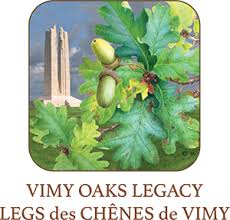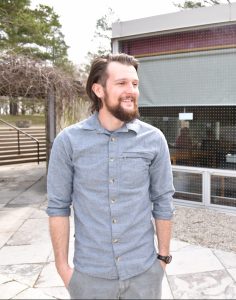
Two oak saplings to be planted at the University of Guelph this week have roots in a Great War conflict considered by many to mark a coming of age for Canada.
Descended from a handful of acorns pocketed by a Canadian soldier after the Battle of Vimy Ridge in spring of 1917, the Vimy oaks will be placed near War Memorial Hall and the John McCrae Trail in U of G’s Arboretum.
The trees will connect U of G and other planting sites across the country with the three-day battle that saw Canadians capture a strategically important vantage point in northern France during the First World War at a cost of nearly 11,000 Canadian casualties, including some 3,600 deaths.
Prime Minister Justin Trudeau and Governor General David Johnston were among dignitaries at ceremonies marking the battle’s centennial at the Canadian Vimy War Memorial in April.
The conflict marked the first time that all four Canadian divisions overseas fought together under a single command.
In 1917, surveying Vimy Ridge after the battle, 28-year-old Lieutenant Leslie Miller picked up a few acorns from a shell-blasted oak tree at his feet.
He mailed the acorns home to the family farm in Scarborough, Ont. After the war, Miller planted them on his own allotted spread, which he christened as Vimy Oaks Farm.
The farm was sold in the 1960s and is now home to a church congregation.
When Monty McDonald visited the property in 2014, he found the oak trees — they’re English oaks, or Quercus robur — towering over the landscape.
In the 1950s, McDonald was only six years old when he first visited Vimy Oaks Farm with his father, a Second World War veteran.
His father ended up working on the farm along with Miller, and so did Monty and his brother.
Three years ago, McDonald decided to pursue an idea that had percolated since he travelled to France and visited Vimy Ridge in 2004, and found no oaks growing there.
Why not use Miller’s Vimy oaks to re-establish the trees in a landscaped planting around the Canadian war memorial?
Initially McDonald wanted to send acorns to France to avoid problems with shipping live plants abroad. But too few acorns were available in 2014.
Instead, he decided to graft cuttings from the trees onto rootstock, a faster and more reliable method. That propagation work is taking place at NVK nurseries in Dundas, Ont.
Sales manager Peter Werder says the nursery has grown about 1,500 Vimy oak saplings, a mix of grafts done in 2015 and saplings grown from acorns harvested in Scarborough last fall.
None of those trees has been repatriated to France because of concerns about shipping live plant material that may harbour diseases. French growers are now nurturing trees from acorns shipped more recently from the Scarborough property.
Meantime, Werder says the Vimy Oaks Legacy Corp. (VOLC) founded by McDonald is now working on a Plan B for those Canadian saplings. As a VOLC fundraiser, the trees are being sold for $125 apiece to schools, parks and commemorative sites across Canada.
When members of a U of G committee planning Canada’s National Garden Day on campus learned of the project, they decided to obtain two specimens.
One Vimy oak will be planted at War Memorial Hall, built in 1924 to commemorate students who enlisted and died in the First World War. Bronze tablets in the building’s chapel list names of campus members who died in both the First and Second World Wars.

That tree will be planted after a dedication ceremony planned for Garden Day on June 16. The event will take place at the Conservatory Gardens, which along with the University trial gardens at the Guelph Turfgrass Institute have been named among 150 destinations on this year’s cross-country Garden Route as part of Canada’s sesquicentennial celebrations.
The second tree will be planted in the arboretum near the John McCrae Trail, named for the Guelph-born author of “In Flanders Fields,” written in 1915.
“We thought it was a great opportunity,” says Sean Fox, B.Sc. (Agr.) ’02, the arboretum’s manager of horticulture and a member of the campus committee. He’s also testing poppy varieties intended for planting along the trail.
For the arboretum planting, Fox plans to involve longtime volunteer Ben Fear. Now 93 years old and living in the Village by the Arboretum, Fear visits weekly to help tend trees. After enlisting with the Canadian forces during the Second World War, Fear served in Italy as a stretcher-bearer and pharmacist’s assistant.
“Amazing” was Fear’s thought when he learned of Miller’s Vimy acorn story. For his compatriots, souvenirs from the Italian campaign included pieces of shell casings and pottery.
“It amazed me that a guy would bring home acorns from Vimy. You don’t think about bringing back orange pips, almonds or olives from Italy,” says Fear.